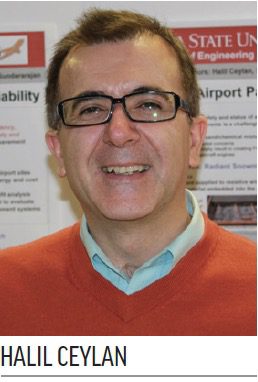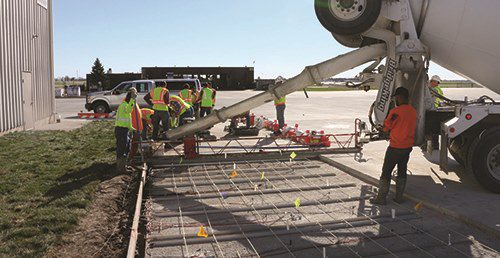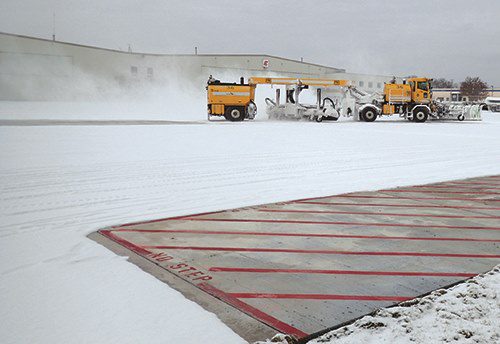Central Iowa may not be the first location that springs to mind for cutting-edge technology breakthroughs, but Des Moines International Airport (DSM) is defying that stereotype. The small hub facility is the first U.S. airport using electrically conductive concrete with embedded electrodes to heat airside pavement. Two test slabs installed on DSM’s general aviation apron in 2016 are producing promising results.
Central Iowa may not be the first location that springs to mind for cutting-edge technology breakthroughs, but Des Moines International Airport (DSM) is defying that stereotype.
 The small hub facility is the first U.S. airport using electrically conductive concrete with embedded electrodes to heat airside pavement. Two test slabs installed on DSM’s general aviation apron in 2016 are producing promising results. Specifically, they are eliminating the need for the airport to dispatch personnel or use chemical agents to remove snow and ice.
The small hub facility is the first U.S. airport using electrically conductive concrete with embedded electrodes to heat airside pavement. Two test slabs installed on DSM’s general aviation apron in 2016 are producing promising results. Specifically, they are eliminating the need for the airport to dispatch personnel or use chemical agents to remove snow and ice.
The project is a cooperative research initiative being performed by Iowa State University and the FAA as part of the federal agency’s Partnership to Enhance General Aviation Safety, Accessibility and Sustainability (PEGASAS).
|
Project: Study of Heated Airside Pavement Location: Des Moines Int’l Airport Technology: Electrically Conductive Concrete Principal Investigator: Halil Ceylan, Professor, Iowa State University Funding: FAA (50%); Iowa State University (50%) Associated Airport Costs: $10,000-$15,000 Project Partners: American Concrete Pavement Assoc.; Asbury Carbons; Central Iowa Ready Mix; Foth Infrastructure & Environmental LLC; GCP Applied Technologies; Iowa Concrete Paving Assoc.; Kingston Services LLC; Zoltek Companies Inc. Of Note: 1st use of this technology at U.S. airport; airport combined installation of test slabs with other planned airfield improvements Preliminary Results: Trial indicates that electrically conductive concrete is technically & economically viable for heating airside pavements Key Benefits: Less need to deploy personnel for snow removal; reduced use of chemical deicing agents |
Bryan Belt, director of Engineering and Planning at DSM, was intrigued when the research team approached airport officials in 2013 about participating in a study to determine the economic viability of the new pavement technology.
“They (university researchers) were looking at ways to heat airside pavements in order to reduce the need for maintenance crews, snow and ice removal equipment and chemicals on pavement surfaces during inclement weather,” recalls Belt. “Initially, they were looking at a geothermal system with piping and pumps cycling heated water or glycol beneath the runway pavements. However, that was determined not feasible economically, and they proposed the installation of an electrically conductive concrete heated pavement system instead.”
The ongoing project at DSM is being led by Halil Ceylan, a professor at Iowa State, founding director of the university’s Program for Sustainable Pavement Engineering and Research, and the school’s site director for PEGASAS. “You can use state-of-the-art snowplows to clear runway surfaces fairly quickly. However, you cannot do that in congested areas such as gates, ramps and high-speed taxiways,” explains Ceylan. “That’s where airport managers and operators are going to get the maximum benefit from this technology. With luggage trolleys, fuel trucks and food trucks operating in the area, you can’t send in large snowplows during winter weather events. Your only option is to use a large number of small vehicles and equipment to try to keep up with snow and ice removal. A lot of accidents happen in those areas. As a result, they became the No. 1 target areas for us.”
By coincidence, DSM was already planning to make apron and taxiway pavement improvements when airport officials agreed to participate in the FAA-subsidized study. So they simply coordinated some of that work with the timeline for the research project. In 2016, crews installed an electrically conductive concrete heated pavement system in two full-size 15-by-13-foot concrete slabs on DSM’s general aviation apron. The airport provided materials and labor, electric power and Wi-Fi service to help researchers visually monitor the surfaces and track data from various sensors.
“We were going to replace those panels of concrete anyway,” notes Belt. “We incurred maybe an additional $10,000 to $15,000 in costs. Of course, this project was being done on a small scale; if done on a larger scale, comparative [per slab] costs would decrease significantly.”
Industry First
The DSM project is the first full-scale electrically conductive concrete heating system installation at a U.S. airport, Ceylan informs. Project engineers eliminated the need to heat the entire 7.5-inch thickness of the concrete slabs by pouring them in two separate layers and adding electrodes and conductive material to the top layer.
Crews began by installing a 4.5-inch bottom layer of P-501 Portland Cement Concrete. When they poured another 3 inches of the same mix (with conductive agents added) on top, the research team guided installation of six electrodes per slab, with fiberglass rebar for protection. Electrical energy running through the embedded electrodes allows the pavement itself to serve as the heat source, explains Ceylan. Carbon fibers added to the concrete mix assist with electrical conductivity.
 “Our technology is unique in that we are using small amounts of conductive agents and are still able to make the system work,” he notes. The concrete mix used at DSM only contains about 1% carbon material per cubic yard of concrete. By comparison, mix designs that use steel shavings or carbon powder to aid electrical conductivity require much more material—25% to 30%. Ceylan notes that higher dosages of conductive material reduce the concrete’s strength and workability, and add to the overall cost of the mix. Steel fibers and shavings are also susceptible to corrosion.
“Our technology is unique in that we are using small amounts of conductive agents and are still able to make the system work,” he notes. The concrete mix used at DSM only contains about 1% carbon material per cubic yard of concrete. By comparison, mix designs that use steel shavings or carbon powder to aid electrical conductivity require much more material—25% to 30%. Ceylan notes that higher dosages of conductive material reduce the concrete’s strength and workability, and add to the overall cost of the mix. Steel fibers and shavings are also susceptible to corrosion.
“By adding carbon fiber, we are improving the mechanical properties of the concrete mix and making the concrete stronger,” he explains. “While our goal is to improve conductivity, we also achieve the additional benefits of strength and durability. The fibers help prevent micro cracks from opening up, and thus improve the long-term performance of the pavements under mechanical and environmental loadings.”
Because the slabs at DSM were designed primarily for research/demonstration purposes, project engineers included numerous probes and gauges to monitor moisture, humidity, temperature, current/voltage and system strain. Crews installed the various measurement devices and equipment when pouring the concrete. In a real-world application of the technology, the system would only require a few temperature probes (with associated conduits) and electrical wires for the electrodes.

Environmental Benefits
Ceylan points out that heated pavement can eliminate the need for deicing and anti-icing chemicals that damage concrete surfaces and contaminate water runoff. This important and substantial sustainability benefit is particularly salient for airports near national parks and other environmentally sensitive areas. Winter maintenance can be very expensive for airports that have to collect and truck away contaminated slush, he explains.
The system can be tailored to various locations and climates by adjusting the electrode size, spacing and voltage used. For example, in Iowa the system requires about 415 watts per square yard to melt ice and snow; in North Dakota, Ceylan estimates that it would need approximately 765 watts per square yard.
While the overarching goal of the research is to help keep airports open, safe and accessible during winter weather events, Ceylan emphasizes that the technology’s sustainability benefits should not be underestimated. Deicing chemicals are harmful to the environment when they migrate into nearby waterways and streams after mixing with slush and runoff water, he explains. The chemicals also reduce pavement life and corrode aircraft parts and airfield lighting fixtures. Heated pavements can eliminate these problems and costs, notes Ceylan.
Dollars & Sense
Results regarding return on investment also seem promising. Ceylan reports that the system’s benefits outweigh its costs with more than 70% reliability, and the benefit-cost ratio increases with airport size. He considers it significant that electrically conductive concrete makes financial sense at a relatively small airport like DSM, which handles 2.9 million annual passengers and 74.9 million pounds of cargo per year.
“Obviously, there are added costs initially,” he elaborates. “However, long-term cost-benefit analyses and lifecycle cost analyses show that the system is a smart choice for dealing with winter maintenance issues.”
After observing the two test slabs, Belt says that electrically conductive concrete would be best applied at DSM near the gates and terminal, where ground handling staff and equipment have to get in and out of tight areas. “During winter months we spend a lot of time pulling snow away from gates and aircraft. That’s where we believe we could see a significant dollar savings,” he shares.
In general, airport officials are impressed by how the pavement system has performed. “Bottom line,” Belt stresses, “right now we can go out there in any inclement weather we have here at the airport, and those two panels are free of snow, ice and are usually dry.”
Bright Future
Given the performance of the test slabs at DSM, Ceylan and his co-researchers have filed for two patents associated with the technology. They are also fielding plenty of inquiries from within the industry.
“Our work has been attracting a lot of attention,” Ceylan reports. “For example, Swedavia Airports contacted us. They have hydronic heating systems with vented tubes placed in concrete and asphalt in which liquids such as glycol are circulated. They indicate that they are experiencing a huge headache because over time the tubes break, crack and leak. Glycol is very corrosive and a huge concern for their airports. They were very excited about this new technology.”
The American Concrete Paving Association is also taking note. “They, too, see the benefits of eliminating the need for deicing chemicals by incorporating carbon fibers into concrete mix,” says Ceylan.
Mainstream interest in the topic is more surprising. In 2018, the technology at DSM was featured on NBC’s Today Show and Nightly News With Lester Holt.
Getting specifications for heated airside pavements added to FAA Advisory Circulars will be a crucial stop in bridging the gap between promising research results and wider deployment of the technology. “Once we get that done, airports will have the mechanisms in place to apply for Airport Improvement Program funding,” explains Ceylan. “That’s an important part of our research project that is currently under review by the FAA.”
In the meantime, officials at DSM are evaluating how the technology could be implemented more broadly at their airport—in particular, how it could fit into plans for the new terminal that is scheduled for construction in 2026. “The system works,” Belt remarks. “We will look at implementing this technology near gates and exposed ramps, and possibly on landside sidewalks in front of the terminal and parking garage. Not spending money on salt, chemicals and staff to keep sidewalks clear is an obvious benefit. Plus, it creates a safer environment for travelers.”

Ultimately, both researchers and DSM officials agree that the future looks bright for electrically conductive concrete at airports.
For more information about the research project at Des Moines International Airport, consult “Sustainable Cities and Society,” Volume 41 (2018), pages 195 to 204.


 facts&figures
facts&figures

